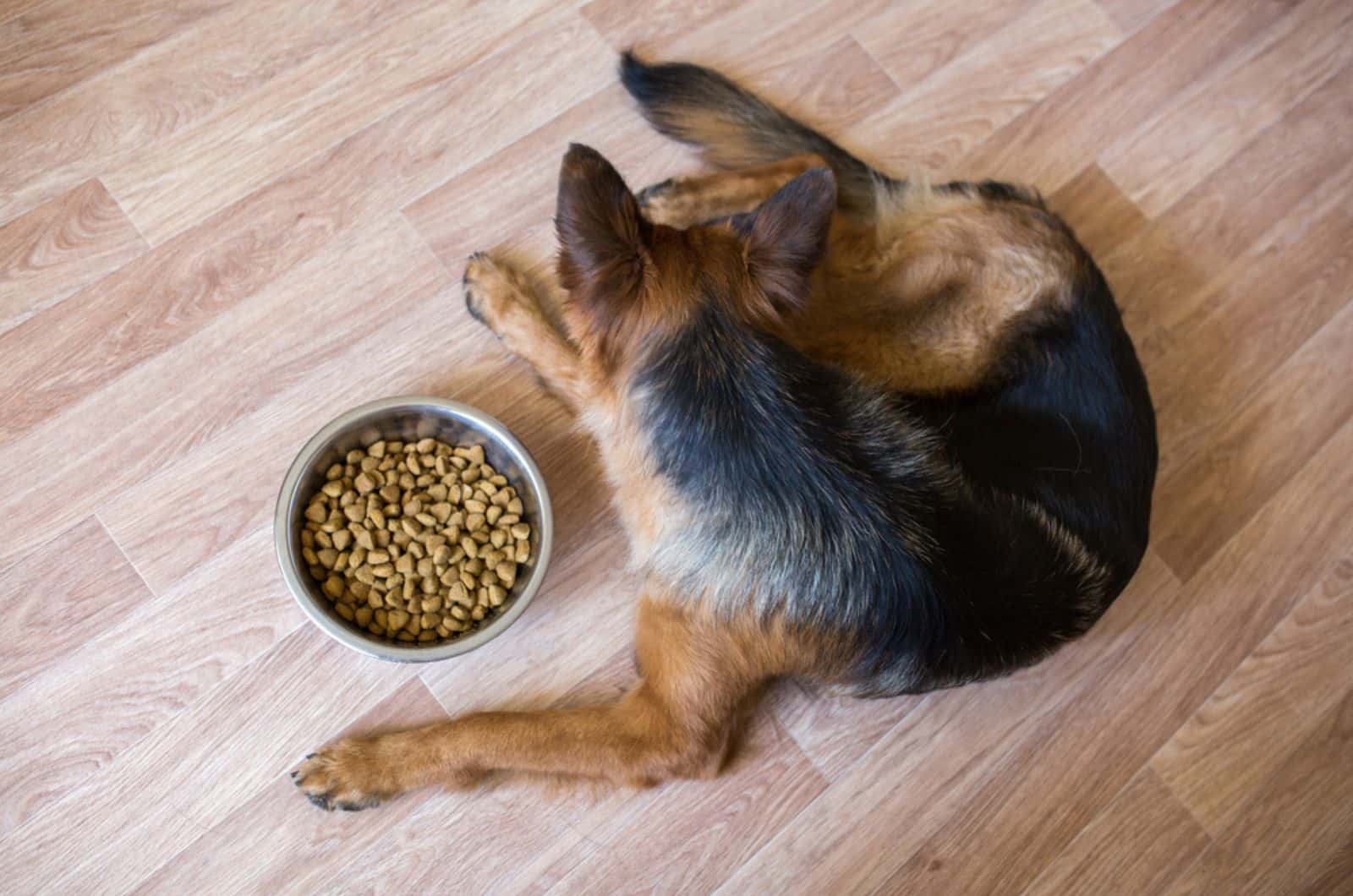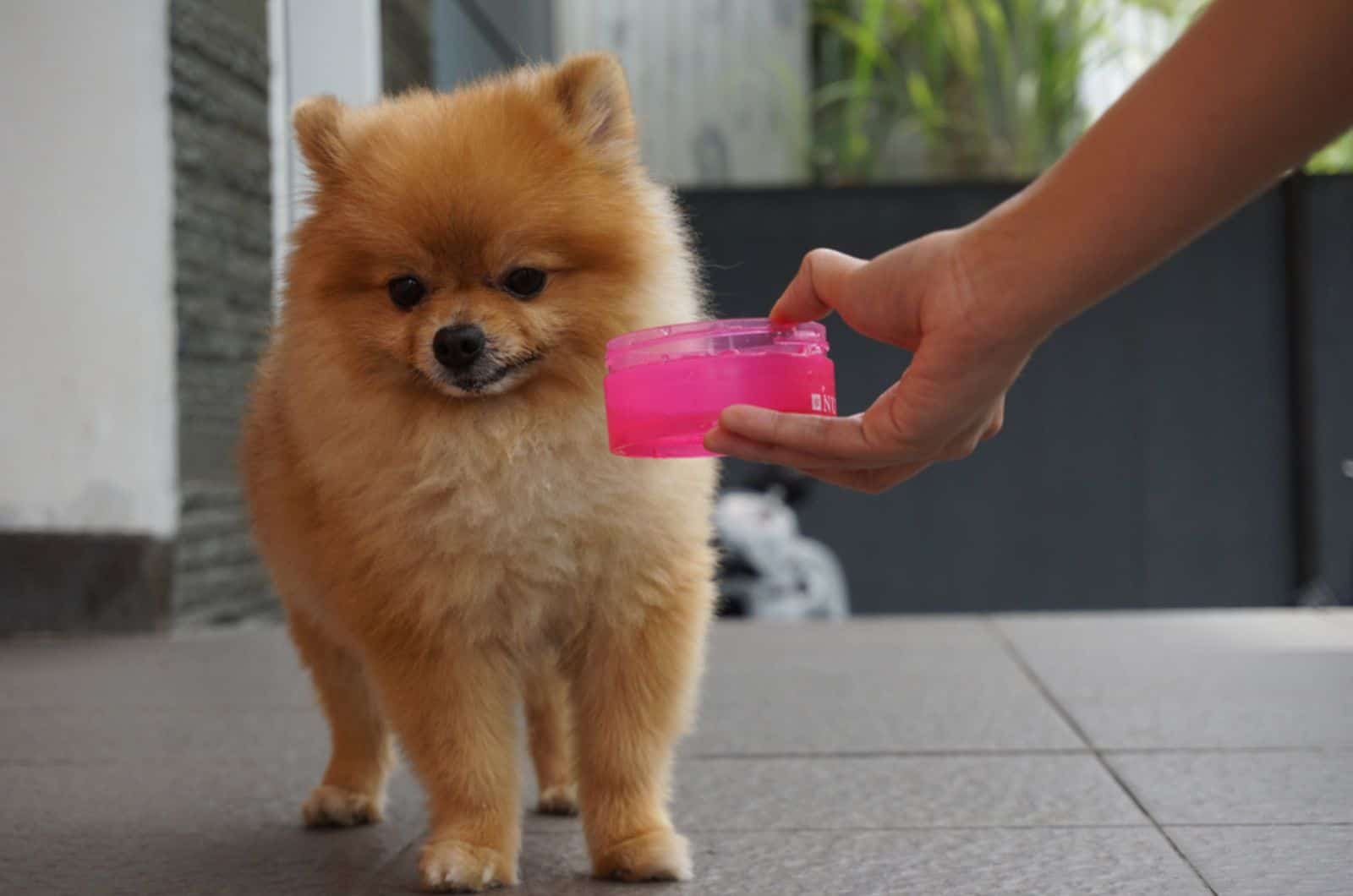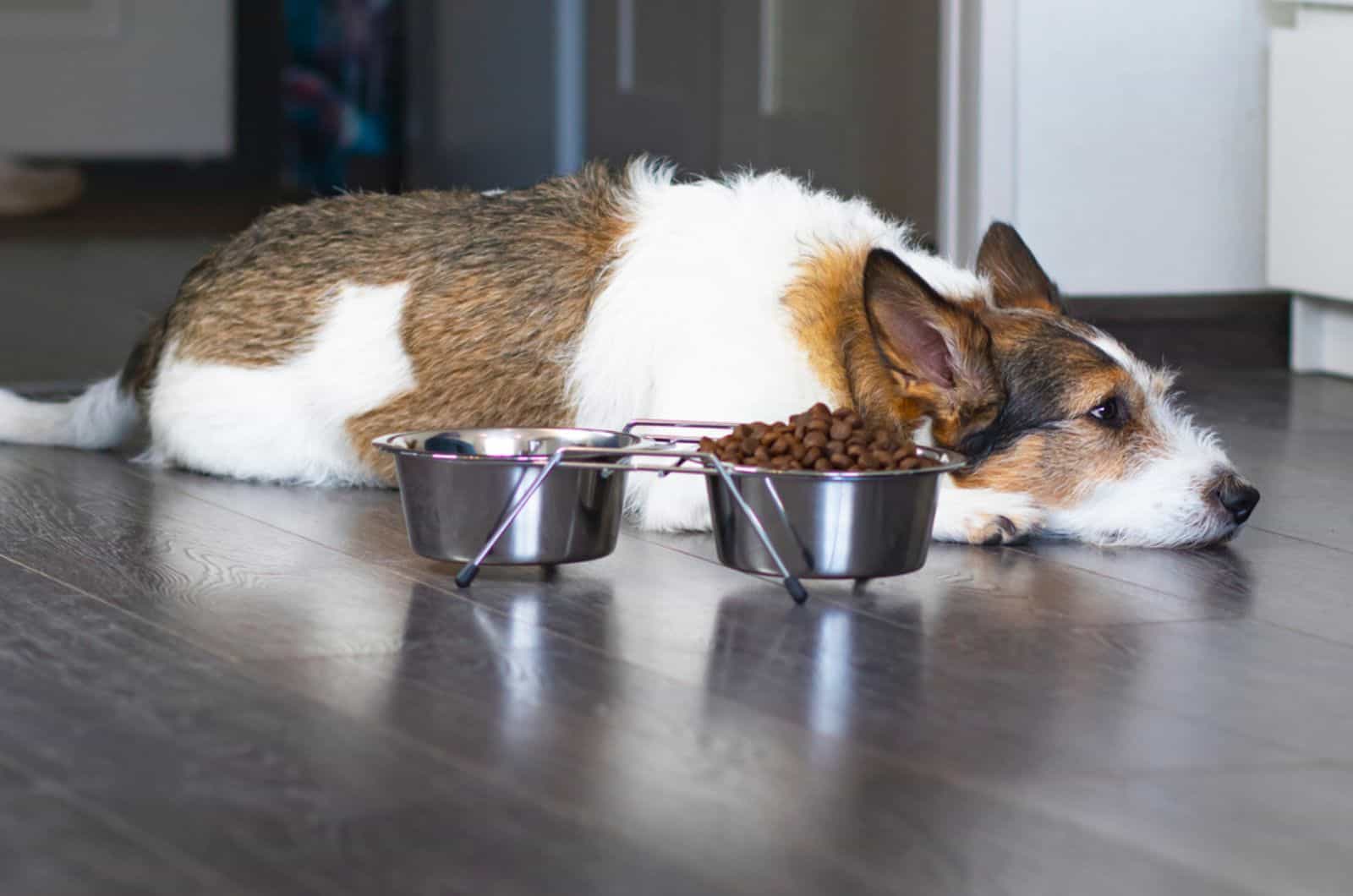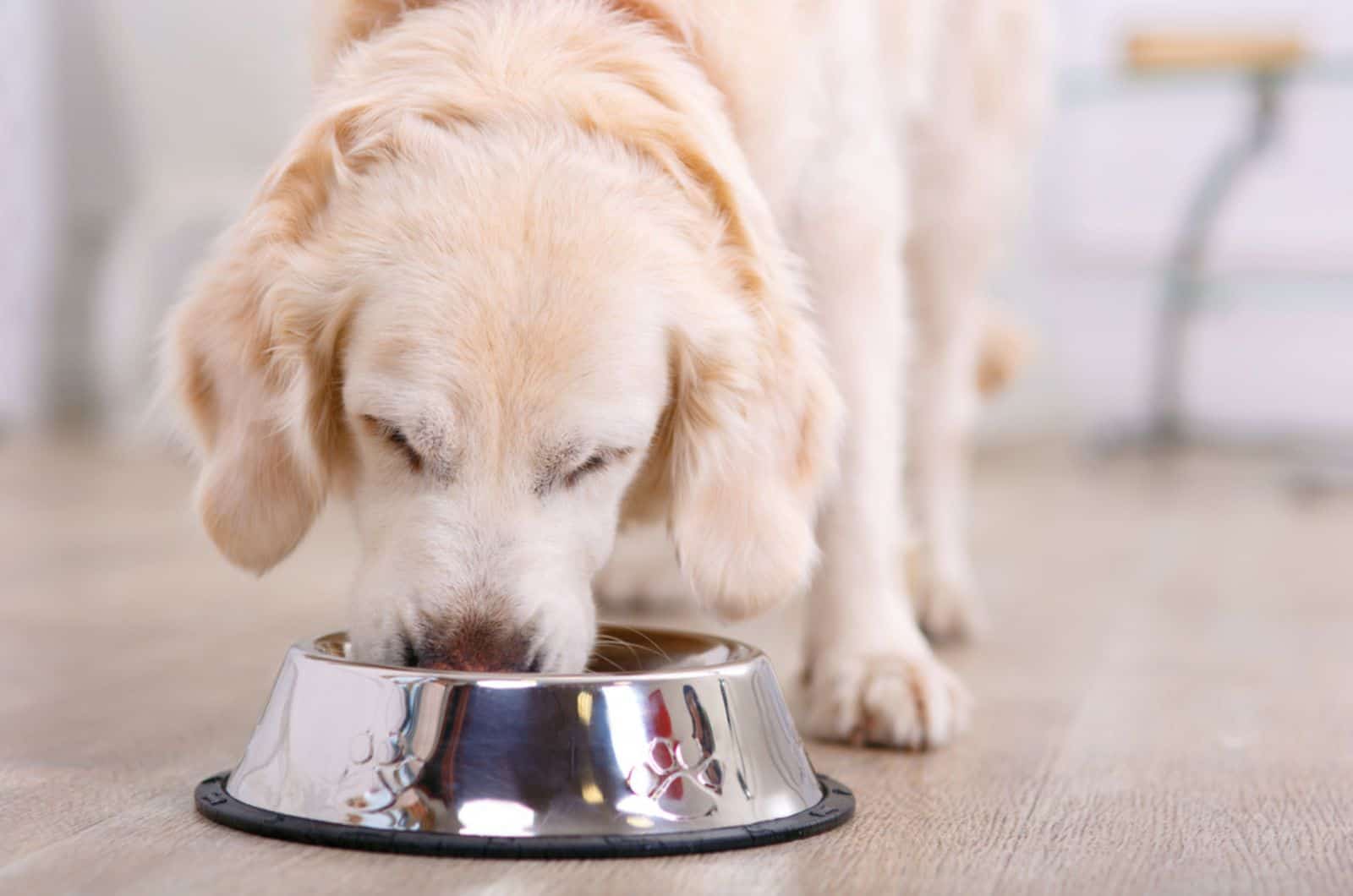Owning a dog comes with many beautiful perks, but some things can be quite overwhelming, and can take a toll on both the dog and the dog owner. Since dogs can’t talk, it is really difficult to realize what might be the problem with some of the things they can go through.
A dog has a way of somehow showing us how they are feeling, but that is more on the emotional side, meaning whether they are happy, sad, or angry. You can see the dog’s ear position or even tail position, but when it comes to more serious things, it is difficult to figure out what is going on.
The worst thing that can happen is your dog getting sick. One of the main things that comes with sickness is a dog losing its appetite. One of the questions that pops in our minds when a dog refuses to eat is, ˝How long can a dog go without eating?˝
In this article, we will be answering this question. Sickness may be the main reason why a dog refuses to eat, but there are some more that we will also go through.
If you want to learn more about this problem, we suggest starting with the topic ,and buckle up because there is a lot to go through.
How Long Can A Dog Go Without Eating?

Seeing your dog refusing food is a very frustrating thing to witness. A lot will go through your mind, and usually, we will think of the worst-case scenario.
We can not tell you not to worry, but sometimes the reason might not be that serious, and can be easy to manage, but we will talk about that a bit later on.
There is a difference between the length that your dog can go through without food according to their health condition, and we will talk about that a bit.
Healthy Dog
It might be strange for some people that a healthy dog can lose its appetite, but it can happen sometimes. The longest that a healthy dog can go without eating is 7 days, especially if they drink enough water.
The main thing that we want to say is that you should never let your dog go for that long without food and not taking it to the vet.
The more realistic time that a healthy dog can go without eating is 5 days. This is also something that is not the best-case scenario, but it is thought that within this period, your dog should not have any major consequences.
Small breeds are a bit different, and it is considered that these small cuties can go without eating for 3 days. Since they eat less than bigger breeds, they will use up all the nutrients that keep them healthy and energized.
If they do not get some food, they might get sick.
Sick Dogs
As we already mentioned, sickness is one of the most common reasons why a dog will refuse to eat, and will have a lack of appetite. There is a difference between a sick and a healthy dog when it comes to this issue.
A sick dog should never go without food for more than 3 days. 5 days without food for a sick dog can be very dangerous, especially if they have a certain medical condition, like vomiting and diarrhea.
They will be losing all the nutrients from their body, and if you add to that that they are refusing food, it does not add up to anything good.
There will be other symptoms that your dog is feeling unwell so when you notice them, you should take your pooch to the vet immediately.
Since your dog might not only refuse food, but will also refuse water, the three-day period might also be very dangerous. But, all in all – 2 to 3 days is the period where a sick dog can go without eating.
Anything more than that and you might have a serious problem on your hands. Unfortunately, these things can happen even when you take your dog to the vet.
A dog that is not eating enough food, especially when it is sick can lower its immune system even more, and they can, for example, lose hair around their eyes or anywhere on their body.
You need to always monitor your dog, and if you see that they are not getting better, there might be a more serious underlying problem, and your vet will need to figure it out.
How Long Can A Dog Go Without Water?

It is a known fact that dogs and even humans can go without food longer than they can go without water. Your dog refusing water is an indication that something serious is going on, and it is connected to health issues in 90% of the cases.
A dog should not go longer than a day or two max without getting water in its system. Two days is also a lot, but it is thought that they can survive that without a lot of consequences, especially if we are talking about sick dogs.
Here are some signs of dehydration:
– Dry nose
– Pale or bright red gums
– Lethargy
– Panting
– Dry gums
– Sticky gums
– Thick saliva
– Loss of appetite
You can also notice your dog either gagging and not throwing up or throwing up a yellowish fluid. If your dog throws up and doesn’t drink water, you need to take it to the vet as soon as possible.
It is very important to monitor your dog, and as soon as you notice that it is not drinking water, and whatever you do, they still do not accept it, you need to go to the vet.
It can sometimes be more difficult to notice that your dog is not drinking. This depends on how often you change its bowl of water.
When you are giving your dog food, you will most likely notice that your dog did not eat, at least to the point of the second meal of the day. But, sometimes it can be that you don’t notice the bowl of water staying full for a whole day.
If you see that your dog is showing any other signs of illness, always keep a close eye on its water bowl.
What Are The Reasons For Your Dog Refusing Food?

You might be surprised at some of the reasons for your dog refusing to eat. Some are more obvious while others are not. Some are also easier to detect than others.
This is why it is a known thing that all dog owners try to learn their dog’s body language, and monitor their dog closely. There are people who keep their dogs mostly outside in the yard as guard dogs.
These people will have problems noticing their dog having issues. But, we believe that you are one of those dog owners who knows their pooches by heart, and that if there is anything wrong with them, you will be able to react quickly.
Here are some of the reasons why your dog might refuse food.
Medical Conditions a.k.a. Your Dog Being Sick
Sickness is for sure one of the factors that will affect your dog’s appetite. Loss of appetite is a common symptom of many health conditions. Of course, it is not the only symptom, but it is the one that usually concerns us the most.
Here are some of the medical issues that can cause your dog to lose its appetite. Some are more serious conditions while others might not be that scary, but whatever the case is, you need to react and take your dog to the vet.
– Hypoglycemia
– Gingivitis
– Upset stomach
– Various infections
– Arthritis (the pain can cause a senior dog or an adult dog to stop eating)
– Allergies
– Cancer
– Diabetes
– Organ failure
– Dental issues
– Parasites
– Autoimmune disorders
These are just some of the conditions. There might be some others that will cause a lack of appetite, but it might not be in every case and with every dog. These are most likely followed by a lack of appetite.
Your Dog Might Be A Picky Eater

This might be funny for some people, but dogs can be picky eaters. Don’t worry – this is not anything that you need to be really worried about. It can be frustrating to figure out what the main cause is because their pickiness can come in a couple of forms.
Some dogs just do not like the taste of certain foods, and it is completely normal. We are all used to dogs eating whatever you give them, which is true in most cases, but some dogs are not about that.
This is something that dogs show while they are in their young-adult stage because this is the time when we try to figure out what is the best food for our pooches.
Some of our options, even when we think are the best, our dog might refuse because they do not like the taste.
Another thing that can happen is that they get fed up with the food that is given to them every day. This can be a common case with dogs that eat kibble every day. They might just get bored of it and refuse to eat even if they are hungry.
They might show you in different ways that they are hungry, but still refuse to eat, and some of those things can be quite weird; for example, they might lick your hand.
This can be difficult to figure out because you might think that your dog is getting sick, but it will not show any other symptoms of being sick, and that is a good thing. When you see that, you will need to experiment with their food.
Introducing your dog to new food can also be tricky because they can fall in love with the taste of certain food, and refuse to eat their own dog food.
It is very important to keep their eating habits and not change them up a lot as they are growing. Sliding your dog a bit of food that we are eating is completely normal, and we are all guilty of that, but if your dog is picky, it can become a problem.
Mental Conditions
Sometimes, people forget that dogs can suffer from some medical conditions just like we people do. The interesting thing is that there are some of the same symptoms with us and dogs that can occur when we are suffering from some mental condition.
There are two main conditions that dogs can suffer from, and those are depression and anxiety.
We will describe them a bit, and we will help you learn how to notice that your dog has either depression or anxiety. The tricky thing is that some of the symptoms can also be symptoms of some other medical conditions.
It will be great news when you take your dog to the vet, and they do not find anything wrong with him. In this case, you will know that your dog is probably struggling with some mental conditions, which is, of course, not the best outtake, but they are a bit easier to manage than, for example, some more serious health condition.
Here are some of the things that you need to know about depression and anxiety.
Anxiety
Anxiety might not be as scary as your dog having cancer, for example, but it is also a thing that you need to take seriously. There are a lot of things that can affect your dog for them to develop anxiety.
Here are some of the things that can make your dog anxious. This list can help you in advance or if you see some of the signs, you can figure out some triggers.
– Not spending enough time with your dog. If you get your dog used to being alone for some part of the day when they are a puppy, they will most likely not develop anxiety, but this depends from dog to dog. This is more connected to a situation where you were spending a lot of time with your dog, and all of a sudden, for various reasons, you needed to be absent from the house for a longer period of time. You will need to make sure that your dog has company. Either get another dog or ask a friend or a family member to spend some time with your pooch.
RELATED: How To Keep A Dog Entertained While At Work: 19 Tips & Tricks
– You moved to a new home. Dogs also get attached to their home, and they most likely have some type of routine that they developed over time. When you are moving from one place to another, they might become anxious because everything is new to them. Keeping their old beds and toys might be a good thing to do because anything familiar can help keep them calm down. Every dog will most likely be confused in the beginning stages of moving, but if you notice your dog staying like that for a long time, you need to take some action in helping them, even contacting the vet.
– Loud noises. This will most likely be a trigger while they are still puppies or very young. This is the reason why it is advised to expose your dog to different sounds and situations. Fireworks are just one of the examples of when a dog can be traumatized. Some dogs will get scared for a moment, some dogs might not even flinch, but others can develop anxiety.
– Attack from another dog. Your dog being attacked by another dog might cause your dog different mental problems. Some dogs become aggressive while other dogs can become anxious. This type of anxiety might not be shown while you are at home. You will notice this when your dog comes in contact with other dogs, especially the ones that they do not know. You should take it slowly, and even hire a professional to try to solve this problem.
RELATED: Younger Dog Attacking Older Dog: 6 Causes Of Aggressive Behavior
– Your dog is not socialized enough. The main thing you can hear when deciding on getting a puppy is socialization, socialization, and more socialization. We agree with this completely. Dogs that have not been surrounded by other dogs, different sounds, different environments, kids, or other people can either develop anxiety or become aggressive. You can potentially have a lot of problems with a dog that is not socialized, and it can affect the quality of both your and your dog’s life.
These are just some of the scenarios that can cause your dog to develop anxiety. There can be many more small things that you might not even notice, but it still has affected your dog a lot.
Some of the behavioral signs of anxiety are:
– Hiding
– Growling
– Barking
– Trying to run away from a lot of different situations
– Refusing to be touched
– Having trouble sleeping
– Having their tail tucked between their legs quite a lot
– Showing a lot of signs of panic while being out or in certain situations
– Shaking for no visible reason
It can be difficult to tell the difference between an anxious dog and an aggressive dog. The main difference is that anxious dogs will not show a lot of anger while aggressive dogs will.
Depression
Depression is tricky for a dog, but it is also really tricky to detect it. A lot of behavioral signs of depression are similar to some other medical conditions. Some dogs might show one or two signs, and this will certainly make it more difficult to figure out that he or she is suffering from depression.
Other dogs might show more signs, and in these cases, you might be able to figure out that depression is what is bugging your dog, not some other medical issue.
Here are some of the things that your dog might show when it is depressed.
– Not willing to play or go outside. This is something that happens to us as well. Dogs that are depressed will not have the desire to go outside and play with other dogs or even their owner. This is something that can easily be noticed, but it can also concern the owner because it can be an indication that something is medically wrong with your pooch.
– Your dog refusing to eat, and even drink. This is also one of the signs that can be concerning because it can lead to some other problems that can get very serious. This is usually in the more severe cases, and it is best to take your dog to the vet when you notice this.
– The dog will change its sleeping schedule. This can appear in different ways. Your dog might sleep a lot during both the day and the night. This can happen because they do not have the will to function as they normally would, and sleeping is something that is the best option for them at that point. They can also mix night with day. This means that they might sleep more during the day and not sleep at all during the night.
– They might not enjoy the things they used to love before. This might be a tricky one to notice because you might think that they just got bored of the toy or treat that they have been loving until that point. If you notice them not getting excited about a lot of things that they usually get excited about, you might be dealing with a depressed dog.
In some cases, they might get suddenly attached to you because they do not know how to express their emotions differently, and they might even be looking for help from you. But, this is not that common, and it depends from dog to dog.
It will be a good thing to take your dog to the vet even if you figure out by yourself that your dog has depression. There are things that you can do on your own to try and help your dog, but it is always a good thing to ask the vet for some advice.
Your dog might also be very depressed, and might even need some medication to help it cope with depression better.
Side-effects Of Some Medication

Whatever the reason is that caused your dog to need to take medication, you need to know that a lot of medications have some type of side-effect. Some might be severe while others might not even be noticeable.
One of the side-effects can be loss of appetite. Some of the medications will have a rule to be given either before or after mealtime. This way, your dog might not lose its appetite.
Listen to the instructions of both the vet and the medication. Your vet will most likely tell you to bring your dog in if you notice any of these, like loss of appetite.
Vaccinations
It is a known fact that every pooch should get their scheduled vaccinations. This process starts while they are puppies, and it can last up to their long adulthood.
Whatever the vaccination is for, there is a big possibility that it can cause some side-effects, and one of the main ones is your dog refusing to eat.
In most cases, the loss of appetite will last only for a day or two, or even your dog just skipping a meal. A missed meal and a day without food is nothing you need to be worried about. However, if you notice your dog not eating for longer than 2 days, you should contact the vet.
Hot Weather
It can sound strange, but dogs can lose their appetite when they are too hot. This is not the case with every dog, but there are some examples that a dog might refuse a meal or two, or even refuse to eat for a couple of days.
This usually has nothing to do with their health condition, but it can cause them to potentially get one. The weakness that comes with heat, combined with lack of food, is not a good formula.
You should keep your dog cool, and not let it outside for long periods of time, especially in the hottest periods of the day.
If you are doing everything that you can to solve this problem, but your dog is still not eating, you should take it to the vet just in case.
What Can You Do When Your Dog Is Refusing To Eat?

Even though it is stressful seeing your dog not eating, and you can even feel helpless, there are some things you can do to solve this problem and make your dog feel at ease and safe.
Some of the things we will list will be specific to a certain problem, and might not help with other problems that caused your dog to lose its appetite.
Take Your Dog To The Vet
We mentioned a couple of times that lack of appetite is one of the most common signs that your dog is not doing well. Even if you know that your dog refusing to eat is not medical, it can still be caused by other things, so you should always take your dog to the vet just to be sure.
We answered the question of how long can a dog go without food, and it is for a couple of days, but if you notice any other symptoms that your dog is not doing well besides them not eating, you should not wait for more than two days.
Your vet will for sure be helpful, and can help you out even if the cause is not medical.
Find The Underlying Cause
This is in the case when you have brought your dog to the vet, and he or she says that nothing is medically wrong with your pooch. At first, you might be very happy because your dog is healthy, but then comes the problem of figuring out what is causing your dog to refuse food.
It can be depression or anxiety, but it can also be something a little bit less serious. Whatever the case is, you need to do your best to find the problem.
Try one thing at a time. Spend a bit more time with your dog, try giving it new food, give it new toys, etc.
This way, you can notice what the problem is. If you do a lot of stuff at the same time, you might not be able to notice what out of all those things was the reason that caused your dog to stop eating.
Change Up Their Diet
The regular food that you are giving your dog on a daily basis might just become a bit boring for him or her. Some dogs have no problem eating the same thing every day, but some dogs like to experiment.
Sometimes, you will just need to change up food brands or stay with the same brand, but try out some other flavors. If this does not solve the case, you will need to change it up a bit more.
You can also change it up from dry food to wet food, or mix the two. If you are not willing to give your dog wet food for a long time, you should just try to mix their kibble with wet food a couple of times.
They can easily fall in love with wet food, but that might not be the best for you.
RELATED: How To Soften Dog Food: 8 Best Solutions
Add Broth To Their Food

Chicken broth or any other type of broth is considered to be an appetite stimulant. This is usually given to dogs that are sick, but you can also try it out with dogs that are picky.
The broth from chicken breast, or… to be honest, any other part of chicken, will make the food smell more appealing, and it will also play and do wonders with your dog’s taste buds.
You need to make sure that your dog does not get used to this taste. This should only be used for bringing their appetite back. Here is a bit of advice on how to boil chicken for a dog.
Wait a.k.a. Let Them Fast
There is a situation where a dog will just not be that hungry. This does not happen often, but you should sometimes just give them some time. Waiting or letting them fast is only in situations when you see that they are drinking enough water, and that they don’t have any other symptoms of some medical issues.
Leave the food around so if they get hungry, they can just come and eat, but make sure that the food is not staying out for a long time.
If you see that there is no improvement in more than 4 or 5 days, you should call the vet for some advice.
Try Hand Feeding
Hand feeding your dog is mostly when they are sick, and they do not have the energy even to eat. At first, your dog might refuse to eat even when you give food from your hand, but do not give up on the first try.
It might take some time for your dog to accept food from your hand, but it might take less time than letting them eat on their own.
Your dog will for sure sense that you are taking care of it, and it will feel safer and at ease by you being around them even in difficult times.
But, keep in mind that they can get used to that, and I am talking from personal experience. A friend of mine owns a Bull Terrier that got a bit sick and refused to eat. They tried hand-feeding, and it was successful.
But, what happened was that the dog didn’t want to eat from the bowl – only from the hands. It took a lot of time to teach the dog to go back to normal.
Let The Dog Eat Grass
You may ask yourself, why do dogs eat grass?, but It is a known thing that they do it when they are not feeling that well. This is usually connected to some stomach problems. It can look a bit strange, but you should always let your dog eat grass.
Just make sure that the area is not filled with garbage because that can cause even more problems.
The dog might throw up after eating grass, but do not let that concern you – it is completely normal. This way, they are letting out anything that was causing them to feel sick.
Treat Your Dog
Whatever the cause of your dog not eating might be, you can treat them a bit. Yes, you can use the usual dog treats, but you can also give them some ˝human food˝.
They will be extremely happy, and it can really boost their appetite. This is something that you should also be careful about because they can get used to this type of food.
You can always pick the home-cooked option for your dog’s diet, but if you are not willing to do that, you should be careful. We don’t blame you for not picking this option because it takes a lot of time, energy, and money to keep it up, as well as a lot of research.
What To Feed Your Dog

There are some foods that will for sure make even a sick dog take a bite or two. They are not just more tasteful and smell better, but they are also easier on the dog’s stomach so even sick dogs can eat them.
Here are some foods that you can give to your dog when they do not have a lot of appetite.
– Baby food
– Any kind of broth
– Shredded chicken
– Plain rice or chicken and rice
– Wet food
– Pumpkin
– Scrambled eggs
– Fish (tuna, for example) or fish sticks
– Sweet potato
– Rice cakes
– Peanut butter
There are also some foods that you should not be giving your dog in general – let alone a sick dog. Some of those foods are:
– Spicy food
– Garlic
– Grapes
– Avocados
– Raisins
– Onions
These foods are not really delicious for your dog, and they can also be harmful so it is better to avoid them. This does not mean that if they have a bit of any of these by accident (and in a small amount), they will have a big problem.
Problems can occur if you give them these on a daily basis.
To Sum It All Up
When you notice that your dog is not eating, the perfectly normal question that you can ask yourself is, ˝How long can a dog go without eating?˝
Illness is one of the main reasons for your dog to stop eating, but it is certainly not the only one. We listed many things that can cause this problem with your dog. Some might not be as scary as an illness, but they will need a lot of attention.
There are also some things that you can do to bring their appetite back. We hope that our list was helpful and that it eased your problems a bit.













